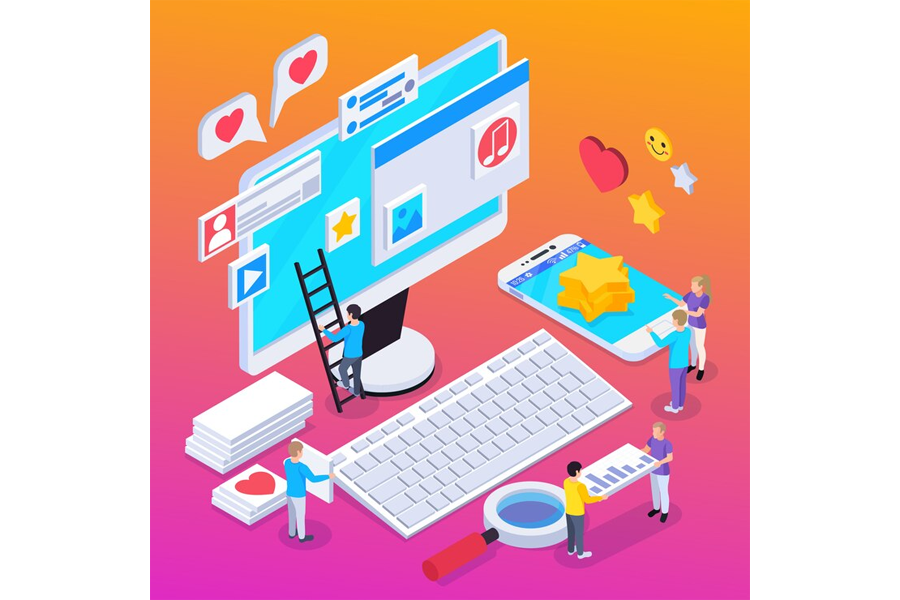
Most businesses use social media marketing to bring their products to the right audience – but only a few are doing it right.
Marketing your business in social media is easy to begin but difficult to master. If you want to stand out, you need to know the ins and outs of social media, starting from the most common social media tools.
So to help you get ahead, we’re going to discuss how to best use social media tools for ecommerce businesses. Let’s dive right in.
Intro to Social Media Tools in E-Commerce
The social media game is rapidly changing industries. Nowadays, social media has become a cornerstone of modern marketing strategies.
In Indonesia, platforms like Instagram, Facebook, and TikTok wield significant influence, with millions of active users engaging daily. According to Statista, as of 2022, there are an estimated 167 million social media users in Indonesia, the third highest in Asia Pacific.
Brands have been utilizing this penetration for their marketing – and you should be one of them.
The power of effective social media marketing is vast. You use it to tap into this vast audience, building brand awareness, driving audience engagement, and ultimately increasing sales.
But to master social media marketing, you must know the right tools available to you. These tools make social media management a breeze. It simplifies processes and enhances productivity. It even provides invaluable analytics about consumer behavior and market trends.
These tools help you stay ahead of the curve and maximize your online presence and profitability. So, what are they? More on that below.
Choosing the Right Social Marketing Platforms
Before we dive into the specific tools, you must have a social media platform in the first place. Selecting the right platform is essential; each attracts specific audiences and is good for different things.
To maximize your Return of Investment (ROI), focus your efforts on platforms aligned with your target audience and business objectives.
Consider factors like your target audience demographics, content format, and campaign objectives to determine which social media network is best.
Here’s a general list of social media platforms and what you can expect from them:
- WhatsApp: One of the most popular in Indonesia, WhatsApp is widely used for one-on-one customer communication. Its direct messaging feature allows for quick and convenient interactions with customers, making it ideal for building strong customer relationships, providing personalized assistance, and delivering order updates.
- Instagram: Ideal for sharing visual content, like pictures and videos. It’s best for visually-driven content marketing, product showcases, and influencer collaborations. It also attracts a predominantly youthful and visually oriented audience.
- Facebook: Facebook stays strong in Indonesia. This platform has plenty to offer: diverse advertising options, community management through groups, customer service interactions, and targeted content sharing to a wide demographic range, just to name a few.
- Twitter: This platform is best suited for news updates and real-time “brand conversations.” It allows businesses to give out real-time updates and customer engagement. It’s also great for social listening.
- TikTok: Best known for its short-form video content, TikTok is perfect for creating viral marketing campaigns among young people. Through this, you showcase products creatively, participate in viral trends, and easily conduct influencer marketing.
Picking the right platform is critical – misalignment between platform choice and audience segmentation wastes resources. You won’t reach your intended audience, so you’ll have diminished engagement. It might even damage your brand credibility.

Top 3 Best Social Media Tools for Every Business Purpose
What do we mean by “social media tools”? Contrary to what you might think, social media tools aren’t just the ones that deal with scheduling, automation, and monitoring social media
posts. These tools are everything that helps you use social media marketing better for your business.
For a more effective discussion, this article will discuss the primary processes that businesses do when using social media. Then, we’re going to discuss the tools that best help you with these categories.
This way, you can optimize everything, from content curation to analytics monitoring. Unlock higher capabilities for your marketing below!
Tools For Crafting Sales-Boosting Content
Creating compelling and useful content is the cornerstone of successful social media marketing. It helps your audience connect with your brand. If your audience believes that your content is useful, they will follow your social media platform and prefer you over competitors.
Thus, good content creation fosters brand loyalty and drives traffic. Ultimately, more eyes on your content means more sales.
Here are the best tools you can use.
- Grammarly: People are always looking for something to read. Enhancing your text content is thus essential for any business and any platform. Grammarly helps in checking grammar, punctuation, and style. There’s also a free version, which checks for basic errors and style. This puts your content a cut above the rest.
- Canva: This tool is a user-friendly graphic design platform that lets you create stunning visuals for your social media posts. You can use templates, fonts, and graphics, in many different formats.
- Adobe Premiere Pro: Video is one of the most powerful ways to create content. This tool is a professional video editing software that provides powerful features for creating high-quality video content. Avail of advanced editing features, effects, and transitions to produce videos for your marketing campaigns.
Use these tools to streamline your content creation process. By consistently creating good content, you increase brand awareness and create more trust for your brand – a winning formula for any social media campaign.
Tools To Maximize The Power of Influencer Marketing
Influencer marketing involves collaboration with people that have grown an online following. Essentially, you align with their influence and credibility to market products or services to their followers, who trust their judgment.
Influencers have an authentic connection with their followers, which creates higher levels of trust and engagement compared to traditional advertising methods.
Here are the top 3 tools to use:
- Sprout Social: This is a social media management platform with powerful collaboration features. This platform identifies influencers and brand advocates and handles contracts, content approval, and payment. It also allows data visualization and sentiment analysis.
- CreatorIQ: Unlike Sprout Social, which is primarily a generalized social media management tool, CreatorIQ is a dedicated, AI-powered influencer marketing platform. Thus, it has features such as advanced influencer search filters, profile comparison, community building, and so much more.
- Heepsy: This platform helps you find influencers for platforms such as TikTok, Instagram, YouTube, and Twitch. You can use features like influencer filters, individual social network analytics checks, list creation and export, and promotional activity and cost estimates.
Influencer marketing is a simple concept, but the actual implementation can be a bit difficult. Navigating research, agreements, payment, and everything else that comes with the powerful capability takes up time.
Using these tools simplifies influencer discovery and collaboration. Streamlined processes enhance the effectiveness of your influencer campaign.

Tools For Effective Social Media Ads
Social media ads are paid promotional content displayed on various platforms. They are shown preferentially to targeted audiences. They can also be different types – for example, there are story ads, post ads, featured posts, and so on, depending on your needs.
Social media ads are a powerful way to increase visibility and directly market to the people who matter. Through ads, you can filter audiences based on demographics, interests, behavior, and so on. You can even do A/B testing to measure post performance.
When it comes to running effective social media ads, several popular tools make your advertising campaign run better:
- Hootsuite: This social media management platform is known for having comprehensive features. It has tools for almost everything. You can schedule ad posts, run advertising campaigns, and provide in-depth ad analytics. They also have cross-platform posting. It’s popular for businesses with large needs.
- Buffer: While it’s not as comprehensive as Hootsuite, Buffer draws its strength from its user-friendliness. It has a simple dashboard for managing everything and has core features for running ads like scheduling and analytics.
- Sendible: Sendible is an affordable all-in-one social media management tool that supports various platforms like Instagram, Facebook, LinkedIn, and more. It’s popular among small businesses and creators.
Social media campaigns are critical if you want to use social media as a driving force for your business. However, managing the intricacies can take up a lot of time. Not using the right social media tool to manage posts and the like will result in lost time and opportunities.
On the other hand, using the right social media ads management tool allows for effective ad targeting, engagement, and measurable results.
Tools For Optimizing Your Sales Funnel
Sales funnels represent the journey that your potential customers go through before they buy from you. This typically ranges from awareness of your brand, to purchase of your offer.
Here are the best tools to help you with that:
- HubSpot. This platform is one of the most popular solutions for improving sales funnels. It’s a customer relations management (CRM) platform that offers custom funnel reports, segmentation, and other optimization features.
- Userpilot: Tracking is one of the most important parts of improving your sales funnels. In this case, Userpilot is one of the best. This is a product adoption platform with advanced analytics, feedback, and user engagement features.
- Funnelytics: If you want to keep a close track of all your funnel content, Funnelytics might be for you. This tool builds detailed funnel visualizations, connects with websites, integrates core data sources, and maps customer journeys.
Optimizing your sales funnels means taking control of the customer journey. Instead of having your potential customers wander around the internet stumbling into your brand here and there, you carefully guide them through making the decisions that best suit their interests.
This process typically means streamlining the customer journey, implementing tracking analytics, and improving conversion rates.
Tools To Help You Use User-Generated Content (UGC) for Sales
UGC refers to any content created by individuals, rather than brands. They are typically shared on social media platforms and thus can become powerful marketing materials for your business if you know how to use them right.
User-generated content includes posts, reviews, testimonials, photos, and videos created by customers. It typically showcases their experiences with a brand or product.
UGC is more trustworthy compared to the typical marketing material by a brand. People relate more to the content because it’s not published by a business, but rather by their fellow internet users. It provides real-life examples and social proof of what it’s like to use the product.
If you want to use UGC for sales, here are a few tools:
- Taggbox: This is a UGC software that specializes in aggregation and analytics — which means that you can gather content from various social media platforms. You can then use these to study market trends and analyze user behavior.
- Vendasta: Reviews are one of the most powerful types of user-generated content. Vendasta is a tool that simplifies getting reviews by automatically contacting users for feedback.
- Showcase.:This platform is a UGC “marketplace,” where you can look for content creators that align with your brand. It also simplifies creator selection, pricing, and payment. Through this, you can easily gather high-quality UGC for your products.
Using UGC properly generates brand credibility. When your audience sees that people like them appreciate your brand, they’ll want to try it too. Potential buyers seek authentic experiences and seek social proof before buying.
Thus, neglecting to leverage social advertising via UGC is a big missed opportunity to build trust and engage customers.
AI and Chatbot Tools for Sales
AI chatbots are automated conversational agents powered by artificial intelligence. They interact with your users for routine things.
Chatbots are used widely to provide assistance and support. They’re often what you’ll encounter when you go to a major company’s social media page, or reach out to them through their customer assistance channels.
Chatbots are highly efficient because they simulate human conversation while minimizing human error and even lowering costs. They are also available to provide 24/7 customer support.
If you think your business can use AI chatbots, here are a few tools to consider:
- Zendesk: This platform uses prewritten scripts and algorithms to simulate human-like conversations. It can answer customer queries, provide product information, and guide customers through the sales process.
- Lyro by Tidio: Lyro is the first conversational AI for small businesses, specializing in business process automation. It integrates seamlessly with CRM systems, automates lead qualification, and even schedules follow-ups.
- Drift: This tool specializes in engaging website visitors and converting them into leads. It offers personalized messaging, lead scoring, and real-time chat.
While chatbots are primarily used for routine customer support, algorithm updates and innovation have allowed them to move beyond that. They can qualify leads, personalize interactions, send out promotions, and more.
However, remember that there’s still a place for human teams in customer service. Chatbots are better paired with expert technicians that customers can escalate to.
Failure to adopt these features properly decreases your efficiency, lowers effectiveness, and creates disgruntled customers.

Social Commerce Integration Tools
Practically everything happens on social media nowadays. If you want to run a successful business in Indonesia, then you should integrate social commerce into your platforms.
Social commerce is when you integrate e-commerce features directly on your platform of choice. You can display products, accept orders, and facilitate transactions without your potential customer ever leaving the website or the app. This greatly simplifies the purchasing process and potentially boosts sales.
Here are the best social media tools to use for this purpose:
- Instagram Shop: If your brand is highly visual, integrating with an Instagram shop is best for you. This platform is rich in social commerce integrations. One of the main features is shoppable posts. A feature lets stories tag products, display prices, and provide direct links for purchases.
- Facebook Shop: Facebook is still a major social media platform in Indonesia, so setting up a digital storefront here is a no-brainer. Facebook shops offer rich product catalogs, visuals, descriptions, and more. You can even directly communicate with Messenger.
- TikTok Shop: This platform is exploding in popularity across South East Asia. One of its main strengths is the ease of partnering with TikTok influencers. Social commerce and influencer marketing — all in one platform.
While social media ads are great, most businesses use them traditionally, with the ad representing a gateway to their website or online store. This is often a pain point for audiences – it takes them several clicks to get to where they want to be (which is buying your products).
If you don’t use social commerce for your business, you unnecessarily lengthen the buying process and you miss out on a massive trend that’s driving consumer sales.
ROI Tracking Tools in Social Sales
To fully maximize your business’ social media sales, you need to keep a finger on your numbers – specifically your ROI.
ROI tracking involves quantifying the financial returns that you generate from social media marketing campaigns and sales activities. This means jotting down advertising spend, lead generation, revenue generated, and similar expenses and gains.
This helps you determine whether your social media campaign is working, and how to improve it.
Here are some tools you should keep top-of-mind for ROI tracking:
- Hootsuite Advanced Analytics: This popular CRM lets you track conversions, conversations, and performance across multiple social media channels. It gives you detailed reports on social data and gives you a thorough understanding of what drives ROI.
- Google Analytics: This is a must-have free tool for anyone who’s not looking for enterprise-level capabilities. It can track website traffic, conversions, and sign-ups from social media campaigns. You’ll see where traffic is coming from, letting you optimize for ROI more efficiently.
- Flick: This social media management tool is focused on providing excellent ROI measurement for social campaigns. It helps you analyze and improve your social media content through features like engagement, organic reach, conversion tracking, hashtag tracking, and even AI-driven content suggestions.
To conduct efficient ROI tracking, you need to have clear objectives and comprehensive, utilize any of these analytics tools for KPI (Key Performance Indicators) tracking, and derive insights from the results.
Neglecting to track your ROI results in a sub-optimal campaign – you might be wasting time and resources, and still lose on sales.

Final Thoughts
Social commerce is one of the most important trends happening right now. If you want your business in Indonesia to succeed, you need to master this marketing strategy.
Social media tools will make marketing on social media platforms easier. In this article, we tackled the most important tools and platforms according to your needs.
Whatever activity for social media you want to do, whether it’s writing your copy or conducting competitor analysis, you have a list of tools at your disposal. Last but not least – the more of these tools you have integrated into your ecommerce website, the more streamlined your efforts and performance will be.
Frequently Asked Questions
What is an API integration?
An API integration connects different software systems to share data and functionality seamlessly, enabling them to work together efficiently. For example, an API integration is used when you connect your website to a service provider’s platform.
What is geo targeting and why is it important for social commerce?
Geotargeting delivers content or ads based on the user’s location, enhancing relevance and increasing engagement for local audiences in social commerce. This is critical if you want to optimize your content as much as possible.
Why is customer engagement vital for social commerce success?
Engaged customers are more loyal, buy more, and talk about your brand to their circles. This contributes to increased sales and revenue in social commerce.